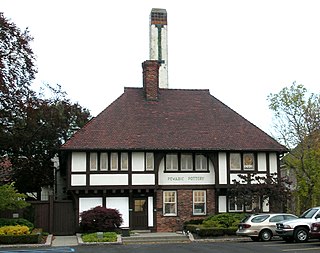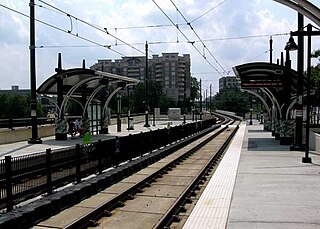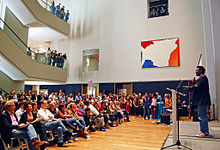
Charlotte is the most populous city in the U.S. state of North Carolina. Located in the Piedmont region, it is the county seat of Mecklenburg County. The population was 874,579 at the 2020 census, making Charlotte the 15th-most populous city in the U.S., the seventh-most populous city in the South, and the second-most populous city in the Southeast behind Jacksonville, Florida. The city is the cultural, economic, and transportation center of the Charlotte metropolitan area, whose 2020 population of 2,660,329 ranked 22nd in the U.S. Metrolina is part of a sixteen-county market region or combined statistical area with a 2020 census-estimated population of 2,846,550.

Mecklenburg County is a county located in the southwestern region of the state of North Carolina, in the United States. As of the 2020 census, the population was 1,115,482, making it the second-most populous county in North Carolina and the first county in the Carolinas to surpass one million in population. Its county seat is Charlotte, the state's largest city.

Pewabic Pottery is a ceramic studio and school in Detroit, Michigan. Founded in 1903, the studio is known for its iridescent glazes, some of which grace notable buildings such as the Shedd Aquarium and Basilica of the National Shrine of the Immaculate Conception. The pottery continues in operation today, and was designated a National Historic Landmark in 1991.
The Penland School of Craft is an Arts and Crafts educational center located in the Blue Ridge Mountains in Penland, North Carolina in the Snow Creek Township near Spruce Pine, about 50 miles from Asheville.
The Charlotte Area Transit System (CATS) is the agency responsible for public transportation in the Charlotte metropolitan area. CATS operates bus and rail transit services in Mecklenburg County and surrounding areas. Established in 1999, CATS' bus and rail operations carry about 320,000 riders on an average week. CATS is governed by the Metropolitan Transit Commission and is operated as a department of the City of Charlotte. In 2022, the system had a ridership of 10,759,300, or about 32,900 per weekday as of the first quarter of 2023.

Uptown Charlotte, also called Center City, is the central business district of Charlotte, North Carolina, United States. The area is split into four wards by the intersection of Trade and Tryon Streets, and bordered by Interstate 277 and Interstate 77. The area is managed and overseen by the Charlotte Central City Partners, which is one of the three Municipal Service Districts in Charlotte. Uptown Charlotte is the largest business district in Charlotte and the Carolinas.

Brooklyn Village, formerly Stonewall, is a light rail station in Charlotte, North Carolina. The elevated dual side platforms are a stop along the Lynx Blue Line in Uptown Charlotte.
Adrian Saxe is an American ceramic artist who was born in Glendale, California in 1943. He lives and works in Los Angeles, California.

Atherton Mill was a heritage streetcar station in Charlotte, North Carolina. The former at-grade side platform was located in front of the Trolley Barn at Atherton Mill and it had served as the southern terminus of the Charlotte Trolley, which connected South End to Uptown Charlotte.

Levine Center for the Arts on South Tryon Street in Charlotte, North Carolina, includes Bechtler Museum of Modern Art, the Harvey B. Gantt Center for African-American Arts + Culture, the Knight Theater, and the Mint Museum Uptown. It was named for Leon Levine, whose foundation provided financing.

The Johnston Building, also known as the Midtown Plaza, is a 17-story office high-rise in Charlotte, North Carolina with an approximate height of 225.65 feet (69 m). Originally 15 stories when completed in 1924, it was the tallest building in Charlotte until 1926.

The Bechtler Museum of Modern Art in Charlotte, North Carolina, is a 36,500-square-foot (3,390 m2) museum space dedicated to the exhibition of mid-20th-century modern art. The modern art museum is part of the new Levine Center for the Arts in Uptown. The museum building was designed by architect Mario Botta.

The Harvey B. Gantt Center for African-American Arts + Culture, formerly known as the Afro-American Cultural Center, is in Charlotte, North Carolina and named for Harvey Gantt, the city's first African-American mayor and the first African-American student at Clemson University. The 46,500 sq ft, four-story center was designed by Freelon Group Architects at a cost of $18.6 million — and was dedicated in October 2009 as part of what is now the Levine Center for the Arts.
Dorothy Auman was a potter, whose works won a North Carolina Heritage Award, in 1989, from the North Carolina Arts Council.

Donald Lester Reitz was an American ceramic artist, recognized for inspiring a reemergence of salt glaze pottery in United States. He was a teacher of ceramic art at the University of Wisconsin–Madison from 1962 until 1988. During this period, he adapted the pottery firing technique developed in the Middle Ages, which involved pouring salt into the pottery kiln during the firing stage. The method was taught in European ceramic art schools, but largely unknown in United States studio pottery.

John Parker Glick was an American ceramicist. Though open to artistic experimentation, Glick was most influenced by the styles and aesthetics of Asian pottery—an inspiration that shows in his use of decorative patterns and glaze choices. His experience working with ceramics led him to publish several articles about the craft. In addition to producing pottery, Glick began making "landscape oriented" wall panels during the latter part of his career. Known as "the people's potter," he is primarily remembered for his contributions to art and the field of ceramics.
Chris Gustin is an American ceramicist. Gustin models his work on the human form, which is shown through the shape, color, and size of the pieces.
Karl Martz was an American studio potter, ceramic artist, and teacher whose work achieved national and international recognition.
The Charlotte Museum of History is a history museum located in Charlotte, North Carolina, United States. Originally founded to be the steward of the 1774 Alexander Rock House, the museum has since expanded its scope to cover all periods of Charlotte's history with exhibits covering everything from the history of music in the city to the experiences of soldiers from Charlotte during the 1st World War.
Michael Sherrill is an American ceramist and sculptor. Primarily self-taught, Sherrill’s early work in the 1970s and 1980s focused on creating functional pieces in clay before turning to sculptural artwork in porcelain and metal in the 1990s. Sherrill lives and works in Bat Cave, North Carolina.
















